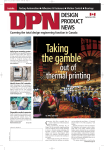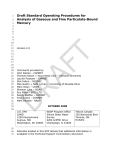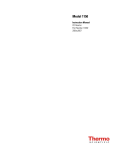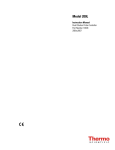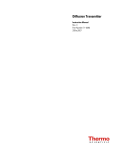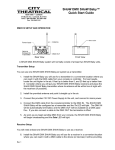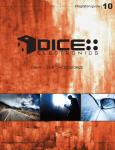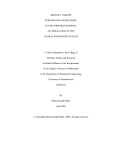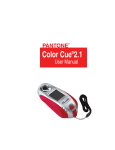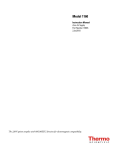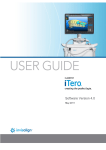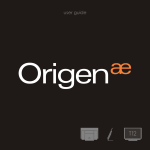Download Model 111 Zero Air Supply - User Manual
Transcript
Model 111 Instruction Manual Zero Air Supply Including External Air Compressor Part Number 7734 20Dec2007 © 2007 Thermo Fisher Scientific Inc. All rights reserved. Specifications, terms and pricing are subject to change. Not all products are available in all countries. Please consult your local sales representative for details. Thermo Fisher Scientific Air Quality Instruments 27 Forge Parkway Franklin, MA 02038 1-508-520-0430 www.thermo.com/aqi WEEE Compliance This product is required to comply with the European Union’s Waste Electrical & Electronic Equipment (WEEE) Directive 2002/96/EC. It is marked with the following symbol: Thermo Fisher Scientific has contracted with one or more recycling/disposal companies in each EU Member State, and this product should be disposed of or recycled through them. Further information on Thermo Fisher Scientific’s compliance with these Directives, the recyclers in your country, and information on Thermo Fisher Scientific products which may assist the detection of substances subject to the RoHS Directive are available at: www.thermo.com/WEEERoHS. Thermo Fisher Scientific WEEE Compliance TABLE OF CONTENTS CHAPTER 1 INTRODUCTION .........................................................................1-1 Specifications................................................................................................................... 1-3 CHAPTER 2 INSTALLATION AND SETUP.....................................................2-1 Unpacking ........................................................................................................................ 2-1 Assembly.......................................................................................................................... 2-2 CHAPTER 3 OPERATION ...............................................................................3-1 CHAPTER 4 THEORY OF OPERATION .........................................................4-1 Gas Scrubbing.................................................................................................................. 4-1 Electrical .......................................................................................................................... 4-3 CHAPTER 5 MAINTANENCE ..........................................................................5-1 Weekly ............................................................................................................................. 5-1 Monthly............................................................................................................................ 5-1 Yearly............................................................................................................................... 5-1 Compressor ...................................................................................................................... 5-1 CHAPTER 6 SERVICING .................................................................................6-1 Spare Parts ....................................................................................................................... 6-1 Service Locations............................................................................................................. 6-2 APPENDIX A WARRANTY ............................................................................. A-1 iii APPENDIX B COMPRESSOR OPERATION AND MAINTANENCE .............. B-1 Installation .......................................................................................................................B-1 Disassembly .....................................................................................................................B-2 Electrical ..........................................................................................................................B-4 Assembly..........................................................................................................................B-4 Inspection.........................................................................................................................B-5 iv LIST OF ILLUSTRATIONS Figure Page 1-1 1-2 Zero Air Assembly............................................................................................... 1-1 Outline Drawing .................................................................................................. 1-2 2-1 2-2 2-3 Interior View........................................................................................................ 2-2 Flow Schematic.................................................................................................... 2-2 Option 006 for H2S Permeation ........................................................................... 2-3 4-1 4-2 4-3 4-4 Model 111 Flow Schematic ................................................................................. 4-1 Component Layout............................................................................................... 4-2 Wiring Diagram ................................................................................................... 4-3 Temperature Controller Schematic ...................................................................... 4-4 B-1 B-2 B-3 Compressor – Dimensional Data .........................................................................B-1 Standard Model 111 Compressor Motor – Exploded View ................................B-2 20 LPM Option Compressor Motor – Exploded View........................................B-3 v CHAPTER 1 INTRODUCTION The Model 111 Zero Air Supply is a convenient system for the generation of pollutant free zero gas for NO, -NOx, -O3, -SO2, -CO, and hydrocarbon monitoring requirements. The Model 111 uses an external compressor; the pressure regulators, chemical scrubbers, reactor and temperature controller are all contained in a single convenient case (see Figure 1-1 and Figure 1-2). The Model 111 has been designed for any application where pollutant free levels of NO, -NOx, -O3, -SO2, -CO and hydrocarbons are required, with flows up to 20 liters per minutes at pressures of 30 PSI. Figure 1-1. Zero Air Assembly 1-1 Chapter 1 Introduction Figure 1-2. Outline Drawing 1-2 Chapter 1 Introduction SPECIFICATIONS Power 115V 50/60 Hz Power Consumption 120 Watts Dimension 12 ¼” H x 19” W x 15” D (suitable for rack mounting) Weight 17 pounds 1-3 CHAPTER 2 INSTALLATION AND SETUP The installation of the Model 111, Zero Air Supply (ZAS) includes unpacking the instrument, connecting the compressor, connecting the gas flow lines, and attachment to suitable AC power. UNPACKING The Model 111 Zero Air Supply is shipped in two containers. If, upon receipt of the supply there is obvious damage to the shipping container, notify the carrier immediately and hold for his inspection. The carrier, and not Thermo Electron Corporation, is responsible for any damage done during shipment. In addition to the basic unit, an instruction manual is included in the shipping container. Use the following procedure to unpack the instrument: 1. Remove the Model 111 from the shipping container and set on a table or bench, which will allow easy access to both the front and rear of the instrument. 2. Remove the Model 111 cover from the main frame of the unit, thus exposing the internal components of the instrument. 3. Check for possible damage during shipment, and then reinstall the cover. 4. Remove compressor from shipping container, unbolt from pallet, and then identify the coalescing filter and pressure regulator. 5. Check for possible damage during shipment. 2-1 Chapter 2 Installation and Setup ASSEMBLY Use the following procedure to assemble the instrument: 1. Using 1/4" Teflon tubing, connect the outlet of the pressure regulator located on the compressor to the input of the Model 111. Note: An optional compressor can be used to supply the higher air flow rates often required in continuous systems. Customer supplied compressed air may also be used, but caution must be taken to ensure that liquid water and oil be completely removed prior to the Model 111. 2. Using 1/4" Teflon tubing, connect the outlet of the Model 111 to the device requiring "zero air" under pressure. 3. Plug the AC line cord into an appropriate power source. Check the voltage and verify before connecting to the power. For 220 VAC operation, a step-down transformer is installed internally in the Model 11’s case. The compressor is operated directly off the line voltage, 115 V or 220 V. Check the plate on the pump motor to determine the correct voltage and frequency prior to plugging in the compressor. Note: If the compressor's power cord has not been installed at the factory, remove the controller's cover on the compressor. Connect power cord to the screw terminals provided. Be sure to connect the ground wire, the line, and the common. Replace the cover. For further instructions on the compressor, refer to Appendix B, “Compressor Operation and Maintenance.” 2-2 CHAPTER 3 OPERATION Once the Model 111 has been unpacked and assembled, you can use the following procedure to power up and operate the instrument. 1. Close the manual valve on the output of the compressor and plug in the compressor. The pressure in the tank should gradually increase to 80 to 90 psi. At that point, the pump shuts off. 2. Open the manual valve and adjust the pressure regulator downstream of the coalescing filter for 70 psi. 3. Adjust the pressure regulator on the Model 111 case for the desired pressure (typically 10 to 30 psi). 4. Turn the dial on the optional CO reactor temperature controller to 350o C. Turn on the instrument. The internal cooling fan starts blowing and the temperature controller light is on. 5. After approximately one hour, the indicating light on the temperature controller is cycling on and off indicating that the reactor is up to temperature. The Model 111 is now ready for use. 6. The compressor’s motor will cycle on and off, with the tank pressure is controlled between 80 and 90 psi. 3-1 CHAPTER 4 THEORY OF OPERATION This chapter explains the gas scrubbing and the electronics of the Model 111. GAS SCRUBBING The purpose of the Model 111 is to supply pollutant-free air (zero air) from the ambient air to allow for proper zeroing, and to provide clean diluent air for spaning ambient air analyzers. The components to be removed are SO2 NO, NO2, CO and hydrocarbons. There is no consensus as to what extent zero air should have water vapor removed. Since many analyzers have longer response times if super dry air (dew point less than -30o C) is used for zero and span, and since water vapor is not a pollutant, the Model 111 does not have a drying system. However, the dew point is reduced as a result of compression of the ambient air. Figure 4-1 is the gas flow schematic for the Model 111. Room air enters the compressor, where it is raised to a pressure of approximately 80 to 90 psi (4560 mm). At 25o C the saturation water vapor pressure is approximately 24 mm. Therefore, most of the water condenses out, and falls to the bottom of the tank. Out of the 4560 mm of pressure in the tank, only 24 mm is due to water vapor. When this air is later expanded to atmospheric pressure (760 mm) the water vapor pressure is reduced to approximately 4 mm. This corresponds to a dew point of slightly less than 0o C. To keep any condensation from occurring in the tubing between the compressor and the Model 111, the output of the compressor contains coalescing filter and a pressure regulator where the pressure is reduced to 70 psig. Figure 4-1. Model 111 Flow Schematic 4-1 Chapter 4 Theory of Operation Inside the main case of the Model 111, the compressed air is further reduced to the final desired pressure (10 to 30 psi). The air then passes into a column of Purafil (potassium permanganate on alumina), which oxidizes NO to NO2. The air then passes through a column of iodated charcoal, which removes NO2, and S02. Finally, the air goes into the reactor where it is heated to 350 oC over a catalytic surface, which oxidizes CO to CO2, and hydrocarbons including methane, to CO2 and water. Figure 4-2 shows the layout of these components. Figure 4-2. Component Layout 4-2 Chapter 4 Theory of Operation ELECTRICAL Figure 4-3 is an electrical schematic of the Model 111 Zero Air Supply. The transformer is installed for 220 volt operation. If the transformer is not installed, a jumper package is installed. Figure 4-4 is the electronic schematic of the temperature controller. Figure 4-3. Wiring Diagram 4-3 Chapter 4 Theory of Operation Figure 4-4. Temperature Controller Schematic 4-4 CHAPTER 5 MAINTENANCE The Model 111 Zero Air Supply has been designed with ease of maintenance as an important criterion. Components and sub-assemblies have been selected for high performance, excellent stability, and long life. The exact lifetimes of the scrubbing material is hard to predict. It is dependent upon flow, pressure, and level of contaminate. For most applications the following recommendation should be followed: WEEKLY If optional automatic drain valve is not installed, open the stop cock on the bottom of the tank and drain water. MONTHLY Check the condition of the Purafil. Fresh Purafil is purple. It becomes brown when it is used up. Replace when the purple color represents less than 20% of the volume. To replace, turn off power and unplug, wait until the reactor cools down (approximately 10 minutes with air flowing). Shut off the air supply so that the Model 111 pressure drops to 0.0 psig. Remove the cartridge holding Purafil. Slowly unscrew the cap, allowing any remaining pressure to vent, empty out the used Purafil and discard. Replace with fresh Purafil. Screw on cover and replace cartridge. YEARLY Replace the charcoal. The procedure is the same as replacing Purafil, outlined above. COMPRESSOR When it is observed that the pump is having difficulty keeping the pressure, rebuilding may be necessary. For directions, refer to Appendix B, “Compressor Operation and Maintenance.” 5-1 CHAPTER 6 SERVICING The Model 111 has been designed with ease of maintenance as an important criterion. Electric components have been packaged in sealed subassemblies for rapid fault isolation and replacement. Components and subassemblies have been selected for high performance, excellent stability and long life. SPARE PARTS The following list includes the recommended spare parts for the Model 111: Part Number Description Quantity 4510 Main Fuse 1 4510 Temperature Controller Fuse 1 7075 Purafil 5 lbs. 4157 Charcoal 5 lbs. 8193 Service Kit for Standard Compressor 1 8221 Service Kit for 20 LPM Compressor 1 6-1 Chapter 6 Servicing SERVICE LOCATIONS For additional assistance, Environmental Instruments Division has service available from exclusive distributors worldwide. Contact one of the phone numbers below for product support and technical information. 866-282-0430 Toll Free 508-520-0430 International 6-2 Appendix A Warranty Seller warrants that the Products will operate or perform substantially in conformance with Seller's published specifications and be free from defects in material and workmanship, when subjected to normal, proper and intended usage by properly trained personnel, for the period of time set forth in the product documentation, published specifications or package inserts. If a period of time is not specified in Seller’s product documentation, published specifications or package inserts, the warranty period shall be one (1) year from the date of shipment to Buyer for equipment and ninety (90) days for all other products (the "Warranty Period"). Seller agrees during the Warranty Period, to repair or replace, at Seller's option, defective Products so as to cause the same to operate in substantial conformance with said published specifications; provided that (a) Buyer shall promptly notify Seller in writing upon the discovery of any defect, which notice shall include the product model and serial number (if applicable) and details of the warranty claim; (b) after Seller’s review, Seller will provide Buyer with service data and/or a Return Material Authorization (“RMA”), which may include biohazard decontamination procedures and other product-specific handling instructions; and (c) then, if applicable, Buyer may return the defective Products to Seller with all costs prepaid by Buyer. Replacement parts may be new or refurbished, at the election of Seller. All replaced parts shall become the property of Seller. Shipment to Buyer of repaired or replacement Products shall be made in accordance with the Delivery provisions of the Seller’s Terms and Conditions of Sale. Consumables, including but not limited to lamps, fuses, batteries, bulbs and other such expendable items, are expressly excluded from the warranty under this warranty. Notwithstanding the foregoing, Products supplied by Seller that are obtained by Seller from an original manufacturer or third party supplier are not warranted by Seller, but Seller agrees to assign to Buyer any warranty rights in such Product that Seller may have from the original manufacturer or third party supplier, to the extent such assignment is allowed by such original manufacturer or third party supplier. In no event shall Seller have any obligation to make repairs, replacements or corrections required, in whole or in part, as the result of (i) normal wear and tear, (ii) accident, disaster or event of force majeure, (iii) misuse, fault or negligence of or by Buyer, (iv) use of the Products in a manner for which Thermo Fisher Scientific Warranty A-1 they were not designed, (v) causes external to the Products such as, but not limited to, power failure or electrical power surges, (vi) improper storage and handling of the Products or (vii) use of the Products in combination with equipment or software not supplied by Seller. If Seller determines that Products for which Buyer has requested warranty services are not covered by the warranty hereunder, Buyer shall pay or reimburse Seller for all costs of investigating and responding to such request at Seller's then prevailing time and materials rates. If Seller provides repair services or replacement parts that are not covered by the warranty provided in this warranty, Buyer shall pay Seller therefor at Seller's then prevailing time and materials rates. ANY INSTALLATION, MAINTENANCE, REPAIR, SERVICE, RELOCATION OR ALTERATION TO OR OF, OR OTHER TAMPERING WITH, THE PRODUCTS PERFORMED BY ANY PERSON OR ENTITY OTHER THAN SELLER WITHOUT SELLER'S PRIOR WRITTEN APPROVAL, OR ANY USE OF REPLACEMENT PARTS NOT SUPPLIED BY SELLER, SHALL IMMEDIATELY VOID AND CANCEL ALL WARRANTIES WITH RESPECT TO THE AFFECTED PRODUCTS. THE OBLIGATIONS CREATED BY THIS WARRANTY STATEMENT TO REPAIR OR REPLACE A DEFECTIVE PRODUCT SHALL BE THE SOLE REMEDY OF BUYER IN THE EVENT OF A DEFECTIVE PRODUCT. EXCEPT AS EXPRESSLY PROVIDED IN THIS WARRANTY STATEMENT, SELLER DISCLAIMS ALL OTHER WARRANTIES, WHETHER EXPRESS OR IMPLIED, ORAL OR WRITTEN, WITH RESPECT TO THE PRODUCTS, INCLUDING WITHOUT LIMITATION ALL IMPLIED WARRANTIES OF MERCHANTABILITY OR FITNESS FOR ANY PARTICULAR PURPOSE. SELLER DOES NOT WARRANT THAT THE PRODUCTS ARE ERROR-FREE OR WILL ACCOMPLISH ANY PARTICULAR RESULT. A-2 Warranty Thermo Fisher Scientific APPENDIX B COMPRESSOR OPEARTION AND MAINTENANCE This appendix explains proper operation and maintenance of the compressor. ! CAUTION: Never lubricate this dry oil-less piston pump. The Teflon filled rings are self-lubricating and require no oil. The motor bearings are grease packed for the life of the bearing. INSTALLATION If this compressor is being installed in a system where it will be periodically required to start against any form of system back pressure, a positive sealing one way check valve should be installed in the air line between the system and the compressor. Check valves are provided as standard equipment on all Gast tank mounted compressor assemblies (see Figure B-1 for dimensional data. A 17 1/4 B 16 5/8 C 5 5/8 D 4 E 10 Standard Model 111 A 26 B 20 7/8 C 13 1/2 D 11 1/2 E 16 20 LPM Option Compressor CIM Free Air Model HP @ Open @ 70 psig @100 psig Standard 1/6 2246 1037 864 20 LPM Option 1/3 4147 2246 1901 Figure B-1. Compressor – Dimensional Data B-1 Appendix B Compressor Operation and Maintenance DISASSEMBLY It is not necessary to remove the filters from the cylinder head as metal chips could be dislodged and enter the unit. Remove the shroud, cylinder head, and valve components. Do not rearrange the valve components. Remove the cylinder and rings. Make sure all parts are clean before reassembling. Refer to Figure B-2 for the Standard Model 111 compressor and Figure B-3 for the 20 LPM Option. Note: Do not use any chlorinated solvents to clean valves, or any liquids to flush units. The stainless steel valves can be cleaned with water. All parts, except the valves, can be cleaned with any industrial, non-flammable, non-toxic cleaning solvent. P/N 8187 (110V) P/N 8188 (220V) * Denotes parts included in service kit. Figure B-2. Standard Model 111 Compressor Motor – Exploded View B-2 Appendix B Compressor Operation and Maintenance P/N 8216 (110V) P/N 8206 (220V) * Denotes parts included in service kit. Figure B-3. 20 LPM Option Compressor Motor – Exploded View B-3 Appendix B Compressor Operation and Maintenance ELECTRICAL Remove the plate covering the electrical terminal for wiring instructions. ! WARNING: The motor might be thermally protected and can automatically restart when the protector resets. Always disconnect the power source before servicing the instrument. ASSEMBLY Use the following steps to assemble the compressor: 1. Install piston seals, piston rings, and rider rings on the piston. 2. Locate ring joints approximately opposite each other and attach cylinder to bracket with the cylinder screws and lock washers. 3. Tighten screws finger tight. 4. Move pistons to top dead center position and adjust each cylinder flush with top of piston and torque cylinder screws to 150 to 160 psi. 5. Re-torque second time. 6. Stack the valve components in order as shown in the detail. The valve leaf is pre-bent and should not be adjusted in any way. 7. Install the cylinder head, lock washers, and head screws. The exhaust ports in the cylinder head are marked, omitting the ends of two of the fins. Do not tighten head screws at this time. Note: Do not tighten head screws at this time. 8. Install manifold and nuts and seals on the manifold and assemble into the other cylinder head and manifold. Torque all head screws to 85 to 95 psi. 9. Re-torque again. 10. Position manifold and tighten manifold nut 1/2 to 3/4 turns beyond hand tight. B-4 Appendix B Compressor Operation and Maintenance INSPECTION If the pump or motor show evidence of overheating or excessive noise, stop immediately for repairs. Regular inspection can prevent expensive repairs. The rider thickness can be an indication of when rings need replacing. If a rider ring measures .05511 or less in thickness, a change of all rings should be made. For a unit operating at sea level, in fairly clean air, at an ambient of 65º to 75º F, relative humidity of approximately 35 percent, and at maximum advertised duties, it is suggested that 4,000 hours of operation be used as an initial inspection point. As operating conditions on your particular application improve or worsen, your own experience can be used to determine whether this 4,000-hour figure can be lengthened or should be shortened. Note: If your pump is equipped with plastic plugs in the exhaust or intake ports, remove them before starting the unit. ! WARNING: To prevent explosive hazard, do not pump combustible liquids or vapors with these units. It is usually quickest and least expensive to send the motor in for repair. Authorized service facilities are located at: Gast Manufacturing Co., Ltd. Halifax Road, Cressex Estate High Wycombe, Bucks HP123SN England High Wycombe 23571 Gast Manufacturing Corp. 2550 Meadowbrook Road Benton Harbor, MI 49022 (616) 926-6171 Wainbee, Ltd. 121 City view Drive Rex dale, Ontario Canada M9W 5A9 Gast Manufacturing Corp. 505 Washington Ave. Carlstadt, NJ 07072 (201) 933-8484 Wainbee, Ltd. 215 Brunswick Blvd. Ponte Clair, Montreal Canada H9R 4R7 (514) 697-8810 Brenner-Fielder & Assoc. 16210 Gundry Ave. Paramount, CA 90723 (213) 636-3206 B-5

































